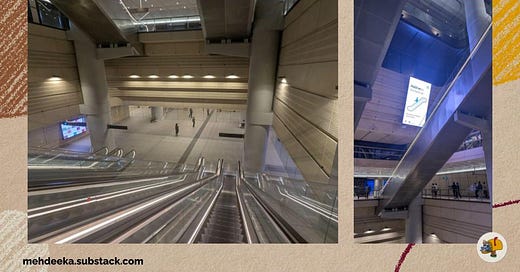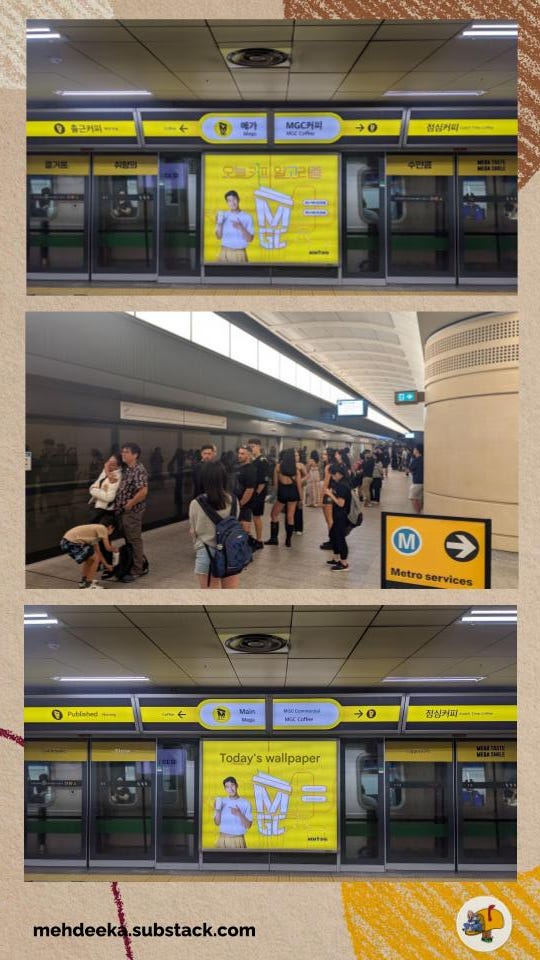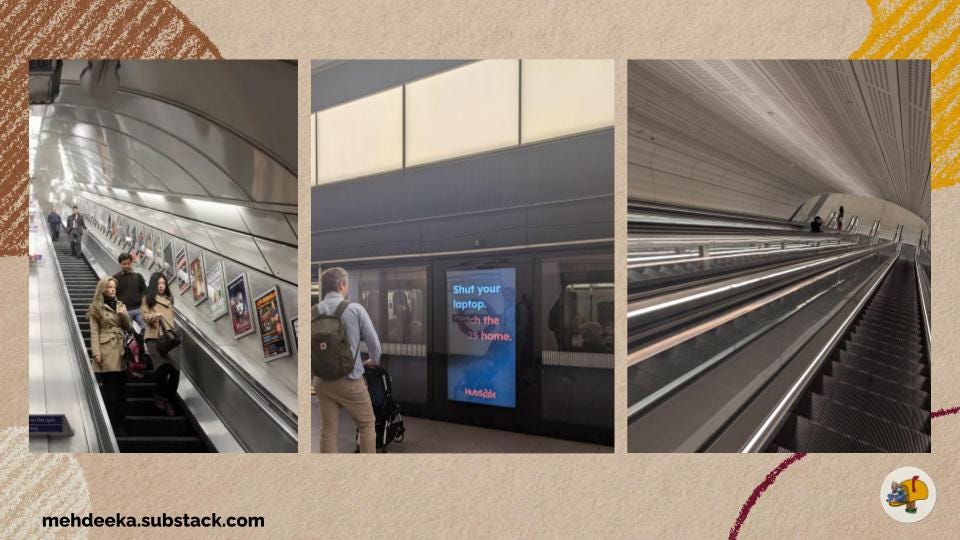📬In this issue:
Warning: This is more of a rabbit hole issue of Mehdeeka, less tactical!
Am I becoming a train otaku? No, but I did use the new Metro for the first time
A vent that the Sydney Metro wasn’t optimised for out of home advertising and therefore is losing out on revenue opportunities (that could reduce ticket prices)
Capitalism vs socialism in trains
Choo choo, Mehketeer,
I wanna say this is a part two to (in my opinion) the definitive best Mehdeeka issue, which breaks down the Japanese train advertising ecosystem:
I took the Sydney Metro for the first time a few weeks ago and was shocked at how little they had done to optimise the advertising inventory. So let’s break it down, compare it to some other transport systems, and then also debate if out of home advertising is actually good for us humans or not.
Part 1: The Sydney Metro
For the non-Sydneysiders, the Metro is a brand new underground metro system that’s so new the whole network isn’t even open yet. Specifically, I went to the Martin Place Metro station, which is still sparkling and not yet grimey.
Keep in mind that the Sydney Metro is operated by Metro Trains Sydney Pty Ltd, which is a joint venture between Hong Kong’s MTR Corporation, John Holland Group, and UGL Rail. It’s a separate operator to the trains system which is run by Transport for NSW (i.e. state owned… for now.) I went to Hong Kong in 2019 which pre-dates Mehdeeka and my obsessive documentation of advertising, however from a quick Google the MTR does have a lot of advertising space.
Back to Sydney: I went at a time when it wasn’t too busy, so I got a really good look at the space (you’ll see how empty it is in the photos below) and was struck by how unutilised the space is.
The concourse has a few large digital billboards on the outer walls, and occasionally has large vertical screens hanging in higher-up levels. But honestly it feels like they missed a lot of opportunities to maximise inventory space.
Maybe it’s to make the space feel more modern, or futuristic — which it does. But, if there’s a Goldilocks spectrum of not enough > just right > too much, this is falling on the “not enough” end of the spectrum. This is far from an intrusive level of advertising.
I have some more specific examples in comparisons to other transport systems, so let’s jump into that.
Part 2: Other countries’ transport system advertising
Asia leads the way with introducing the anti-suicide doors on platforms, and they’re also leading the way with creative subway system advertising. Here’s a comparison between a campaign in South Korea advertising a coffee chain that incorporates the platform screen doors.
These images compressed horribly, but the key points of the campaign is that it incorporates the “this station”, “next station”, and “previous station” signage. I included a Google Translate of the campaign, but you can’t really see it. It says “morning coffee” for the previous station, “Mega Coffee” which is the name of the chain for the current station name, and “afternoon coffee” for the next station.
Note: these were spread out along the platform, not on every door, so you could still navigate and it didn’t prevent you from knowing where you were.
Compare that to the middle image of the Sydney Metro. Nothing! And no billboards on the wall opposite the platform screen doors either. I even walked up and down and went to a second platform to check to see if I had missed them.
The next comparison is Japan. Specifically, just the concourse because the rest of Japan’s train advertising ecosystem is incredibly advanced. (Once again, go read the train issue, it’s genuinely my favourite Mehdeeka!!)
The pillars in particular seem like a let down. A brand new construction didn’t want to put screen wraps on the pillars?! Other things to note is the frequency of billboards on walls in and around the stations. I’d say Japan veers too far towards “too much advertising”, but gets away with it because it’s so long established. I don’t think you’d be able to introduce this level of advertising to a society that didn’t already have it.
Next up, we have the London Tube.
Credit to Business Insider for that first image of the London escalator. Notably, the iconic posters line the entire length of the escalators at most (if not all?) Tube stations. The middle image is from a platform on the new-ish airport line in London, and the image on the right is the Sydney Metro.
I’m not saying every square inch of space should be plastered with posters but there is room for more inventory, which takes us to….
Part 3: Public advertising - an eye sore or good for the public?
Famously, Hawaii banned all outdoor advertising. No billboards, no shop signs on sidewalks, no bus stop ads. It was to prevent interrupting the natural beauty of the islands, and has come to be not only a fun trivia fact, but also a hallmark of Hawaii’s public spaces.
Despite being a marketer, a big part of me really like this!
The tax payer in me wishes public transport ticket prices were subsidised by advertising taking place inside stations.
The capitalist in me wishes there was more inventory to drive down prices and increase accessibility to out of home advertising.
The technologist in me sees a huge wasted potential to introduce new formats, experiential elements, and cool architecture.
So, I’m conflicted on this, but not enough to not have an opinion. They should have done more. It could be a breakdown in the planning process where the architects didn’t consult the advertising arm or whatever. It’s definitely a missed opportunity that will be difficult to retroactively fix in a way that isn’t janky. The screens in Wynyard tunnel come to mind as an example of “very cool” and “integrated into the architecture itself.”
What I think happened:
MTR’s role in the joint venture is purely the operations of the trains, not the stations themselves, which was most likely completed end-to-end by John Holland seeing as they are property developers. This is (allegedly) a shame, because MTR would have had great input on the advertising ecosystem of Hong Kong and larger east Asian trends in general.
Asking other people for their opinions
I would say a solid 90% of this issue is taking educated guesses at best and complete stabs in the dark at worst. So I thought I’d reach out to both oOh! Media and Caasie.co, two out of home advertising specialists and tell them to tell me where I’m wrong.
oOh! gave me a super interesting piece of information:
“Sydney Metro OOH roll-out is ongoing, so there will be more assets appearing at stations on the network over coming months. The number and placement of screens has been strategically designed to enhance the commuter experience and provide brands an unrivalled opportunity to connect with travellers in premium environments”
This is really interesting and surprising! Retrofitting seems like extra work, especially when it’s been open for less than a year, but I will be keeping an eye out for changes.
And from Jeff Jaraved at Caasie.co, I got a great soundboard of contemplation:
There's a pretty deep rabbit hole you can go down thinking about whether a given scenario could be subsidised by advertising. We've even done it to doctors offices.
I'm probably a little bit biased in that I do think ad support helps in the long run when it comes to subsidising the cost of a service like in the case of the trains. Or at least providing the extra revenue that makes the customer experience that little bit better (e.g. more amenities).
Outdoor ads are weird in that way - they're passive so they're not really frustrating to look at in the same way as a Youtube ad. You're not forced to look at them, they're just there, so it doesn't really hurt in most scenarios.
That said, it reminds me of the giant digital billboard floating at Miami Beach.
I think this case is probably the other extreme - it's like, what's the benefit here? You're at the beach to kind of escape the city stuff and this kind of ruins it. But I think that's the difference here, the product IS the beach, and the billboard here isn't passive - it's actively ruining the beach! Contrast with Train stations and well, the product is the transport and crucially the billboards don't interfere with that.
The walls are ugly anyway, so why not toss up some interesting posters or screens to liven up the experience a bit?
This train is departing
There’s nothing I love more than a rabbit hole about marketing, so I’m glad I’ve successfully sucked at least one person into thinking about this. Would love to hear your marketing obessions too!
🚂Choo choo,
Kayla








